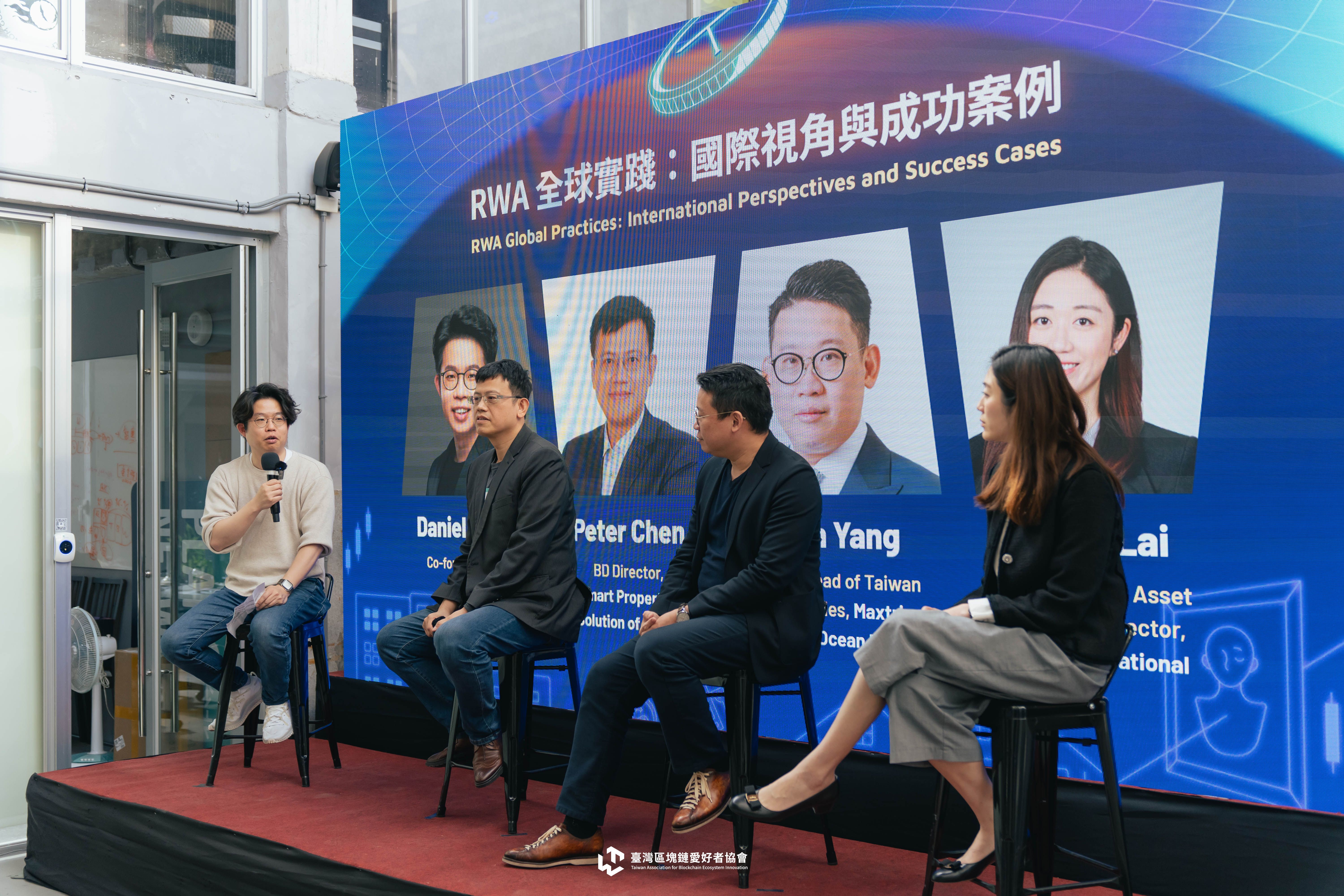
Global RWA Insights from Fidelity, Tether, Maxtriport, and BSOS
Daniel Huang, CEO of BSOS, moderated a panel titled “RWA in Action: Global Perspectives and Success Cases,” featuring Giselle Lai from Fidelity International, Peter Chen from Tether, and Ethan Yang from Maxtriport and Ocean Finance. The session offered cross-industry insights from the perspectives of asset managers, stablecoin issuers, and native Web3 builders.
Can Web3 Native Teams Still Play a Role in RWA?
Daniel opened by highlighting a shift in RWA leadership: “RWA started within crypto circles, but traditional financial institutions are now leading the narrative, leveraging their scale and credibility. So what role remains for Web3-native teams?”
Ethan Yang responded, “Trust is central to finance. On-chain assets like BTC and ETH can rely on smart contracts and private keys, but RWA requires strong links between tokens and real-world assets. This often relies on traditional finance mechanisms like custodianship and bankruptcy protection—Fidelity and BlackRock already have solid frameworks for this.”
However, he emphasized that Web3-native teams bring vital value beyond infrastructure—namely, how to make RWA tokens come alive. “As Professor Hsieh Ming-Hua pointed out earlier, RWA must avoid becoming siloed. The worst outcome is a tokenized asset no one buys. Even worse: an asset someone buys and just holds to maturity with no secondary market or applications.”
He cited Franklin Templeton’s RWA fund, which took five years to reach $360 million AUM, while BlackRock’s BUIDL fund hit $1.8 billion in a single year. “The difference? Web3-native partners like Securitize, Ethena, and Ondo created robust liquidity infrastructure. That’s the Web3 advantage.”
Fidelity's RWA Strategy: Building Safe Entryways into Digital Assets
Daniel asked Fidelity about its RWA outlook and implementation strategy. Giselle Lai, Director of Digital Asset Investments at Fidelity International, said, “Fidelity’s vision is to provide investors with a safe and trusted window into digital assets. We see blockchain’s potential in enhancing financial inclusion.”
She shared two key RWA focus areas:
- Fund Tokenization: Improving transaction efficiency and unlocking new asset allocation strategies.
- Real Asset Tokenization: As more real assets migrate to blockchains, integrating them into investment portfolios becomes critical.
Fidelity has been actively involved in major RWA initiatives, including:
- Investment in Hong Kong’s first tokenized green bond.
- Participation in Singapore MAS's Project Guardian.
- Involvement in the HKMA’s e-HKD Pilot Program.
Tether’s RWA Strategy: From Infrastructure to Liquidity
Tether, the world’s largest stablecoin issuer, also shared its three-pronged RWA strategy:
Hadron Platform Tether has integrated its decade-long expertise into the Hadron platform, offering financial institutions tools for AML/KYC, automated token issuance, and banking integration. Peter Chen emphasized, “This is not a one-company job—we need partners like BSOS to grow this ecosystem.”
Liquid Network (Bitcoin Layer 2) In partnership with Blockstream, Tether promotes the Liquid Network, which leverages Bitcoin’s security for asset tokenization. “While Bitcoin was once seen as inflexible, its security makes it a strong base for RWA.”
Bitfinex Securities An independent platform focused on STOs and RWA token trading—including both primary issuance and secondary markets—featuring high-trust assets like U.S. Treasuries and gold. “Eventually, even Nasdaq-listed stocks like MicroStrategy could be available as RWAs,” Peter noted.
Taiwan’s Potential as an RWA Exporter
Ethan Yang addressed Taiwan’s unique opportunity: “Traditionally, Taiwan imports financial products—offshore funds, foreign bonds. But with RWA, we can become exporters.”
He cited Taiwan’s strong stock performance post-COVID, with funds like Yuanta’s tech ETFs ranking among the top global equity performers. “Yet foreign investors can’t access them easily. RWA could bridge that gap and help Taiwanese institutions distribute products internationally.”
Bridging the Knowledge Gap: The Biggest Hurdle for Institutions
Daniel shared his experience: “In RWA meetings with institutions, 90 minutes are often spent explaining blockchain fundamentals before we can even discuss the product.”
Giselle acknowledged this, adding, “Fidelity began studying blockchain in 2015 and started mining Bitcoin to understand the tech firsthand. Since 2022, we’ve built an internal blockchain team and run cross-departmental training to build literacy. We also invest in Web3 teams through our VC arm to stay close to market trends.”
“Everything circles back to client demand,” she said. “When there’s demand for tokenized funds, we’ll pursue them.”
The Power of Fusion: Web3 and TradFi Collaborating
Daniel asked Peter about the increasing cooperation between Web3 and traditional finance. Peter shared Tether’s experience: “In the early days, crypto and banks were worlds apart. But things are changing, especially in emerging markets like El Salvador.”
Peter recently attended the Plan B Forum in El Salvador and was impressed by government efforts to embrace digital assets and attract high-tech companies. “Google has offices there, and more institutions are coming. Tether is investing resources there—some of our HQ functions may even move.”
Looking Ahead: 2025 as the Year of RWA Execution
Panelists wrapped up with their outlook for 2025:
**Ethan: “This is the year of institutional engagement. The success of BUIDL and USDY, coupled with regulatory clarity, marks a turning point.”
Giselle: “I hope to see more institutions enter RWA. Key challenges remain—interoperability, liquidity, regulatory fragmentation—but it’s an exciting time.”
Peter: “Tether rarely takes the spotlight, but we’re committed to supporting Taiwan. With clear regulations, we can help promote great projects globally.”
Daniel: “Convergence isn’t just a trend—it’s happening now. It will reshape the RWA landscape and the roles everyone plays.”**